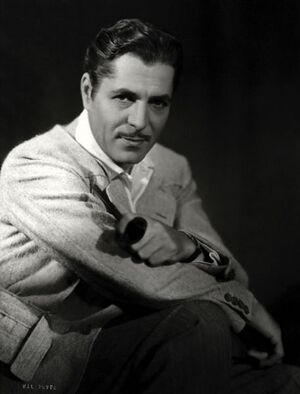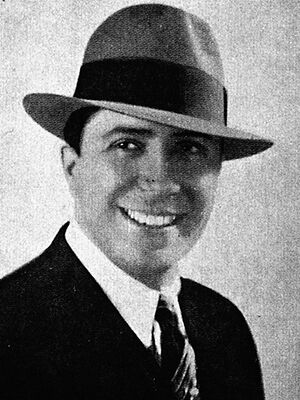Guillermo Luna
Guillermo Luna | |
|---|---|
 Guillermo Luna in a 1952 publicity photo. | |
| Chairman of Federal Housing Board | |
| In office 1 January, 1949 – 20 July, 1985 | |
| Preceded by | Office established. |
| Succeeded by | Stefano Correa |
| Personal details | |
| Born | May 13, 1911 |
| Died | September 7, 2004 (aged 93) Maracaibo City, Maracaibo |
| Cause of death | Pulmonary Embolism |
| Resting place | Chinendega National Cemetery |
| Nationality | Sylvan, Maracaibean |
| Alma mater | National University at Chinendega, Sylva Royal Engineering Academy |
| Known for | Major Expansion of Maracaibean Infrastructure, Establishing National Housing Programs |
Gulliermo Luna (May 13, 1911 - September 7, 2004) was a Maracaibean architect, infrastructural engineer, and public official who headed the Maracaibo Federal Housing Board from its establishment in 1949 to 1985. He is perhaps best known for masterminding the Reconstruction of Maracaibo and the Federal Housing Board. He also played an instrumental role in the construction of the Maracaibo Coast Highway. His involvement in the Reconstruction period is nearly universally lauded for its competency, but his legacy in whole is controversial, owing in part to the wide range of power he was granted, as well as his connections to the Maracaibo Mafia.
Under his leadership and guidance, the Federal Housing Board built thousands of multi-family dwellings, housing the majority of the urban population of the country.
Early Life & Education
Guillermo Luna was born in the city of Chinendega in May of 1911. He attended his local primary and secondary schools, and traveled to Sylva in 1929 to study Infrastructural Engineering and Architecture at the Royal Engineering Academy. He returned to Maracaibo in the Spring of 1936 in order to start work at a local architectural firm. Under this firm, Luna designed two stone railroad bridges, created plans for expanding the capital city, and drew up preliminary plans for what would become the Channel Span.
Pan-Septentrion War
In the Summer of 1943, the Maracaibean Front of the Pan-Septentrion War (The Patriotic War), broke out. Guillermo Luna spent the first six months of the war advising the City Guard on infrastructural conditions and road clearing before joining the local engineering battallion as a commissioned officer in January of 1944. His plans for bolstering the defense of the capital were noticed by High Command, and were adopted in a significant way. This was crucial in the endurance of the city in the subsequent Siege of Maracaibo in 1945. By the time of the Dayashinese surrender, Luna had risen to the rank of Major. In 1947, he voluntarily relinquished his commission and retired back to civilian life.
Rise to Power
In 1947, the Interim Government held a consitutional convention to form what would become the Allied Nations of Maracaibo. The country was largely in ruins, with very little of the developed areas being untouched by the ravages of war. In the yearlong convention, Luna was namedropped by one of the generals on the board. He was tapped to become part of one of the new Federal Agencies which would dictate the Reconstruction Era. In 1948, while the Constitution was being ratified, Luna found himself in competition with several others as to who would control the proposed Federal Housing Board. Luna employed conversational skills and managed to both outmaneuver and befriend his competition. By December of 1948, he was the clear frontrunner for the first Chairman of the Board, and he was given the oppurtunity to handpick half of his board members. All six them were fellow candidates, while the other half was added by provincial delegate vote.
The Federal Housing Board
On 8 December, Rahui Irepani was confirmed to be the first President of the Allied Nations. Immediately, work was cut out for him and his administration. One part of that administration was the Federal Housing Board, chaired by Luna. Irepani was facing a mass homeless crisis, and infrastructural damage across the board, among other things, so his administration granted sweeping powers to the Board. Among these was the power of eminent domain without seeking approval of other parts of the government, complete control over the design and quality of the new domiciles built, control over the local infrastructure insofar as to erect a settlement, and the power to build infrastructure where there was none in order to satistfy housing needs. Later, Board powers were further expanded and clarified. In 1950, it gained the specified right to demolish informal settlements to make room for proper permanent development.
Early Design Philosophy
Because of the acute situation presented to Luna, early buildings of Board design were relatively simplistic. They were created using materials reclaimed via the Recycling Initiative, and contained basic amenities in a traditional style. These Lunarian Estates were built to stave off the homeless population, and so were of average build quality, and made from cheap materials. This kind of thought persisted until the summer of 1951, where Luna presented a new idea to his Board.
El Microdistrio
Throughout the fall and spring of 1950-51, Luna had spent some time designing what he termed as a "self contained city". A single space of considerable size could hold many apartment buildings, a greenspace, a playground, a school, a general store, and several municipal services. They would be divided by arterial roads. There was a large amount of prime construction-worthy land around urban areas after the war as well, so it was a perfect storm. The government had granted Luna a sizeable fund in order to achieve his vision, and so he set to work securing the land to build the first test settlement of Madera. This first microdistrio was built for 2000 people, and was built from the ground up over the course of a year. Overall, the Board considered this idea a success, and in the summer of 1952, gave their approval of fifty more more ambitious sites in and around metropolitan areas.
Modularization
While construction continued, Luna continued to innovate. Applying his knowledge of the advent of replacable parts, Luna proposed the modular apartment building to the Board in 1952. It was met with some criticism immediately from those accustomed to building in the conventional manner. Luna laid out the benefits of the modular apartment to the Board in the Fall of 1952. He argued that a standardized building plan made work faster. He further argued that building each apartment in a factory would bolster the heavy industry of the nation, and employ thousands of by now out-of-work skilled tradesmen--veterans of the Patriotic War. Luna emphasized that both the time savings in on-site construction and assembly were significant, and that the quality of each homestead would be "up to the standard of a wary artisan". On a vote of 8 to 5, Luna was given the approval of the Board to set up prefabrication factories in select parts of Maracaibo.
In 1954, the first modular microdistrio was built in Luna's hometown of Chinendega. The district housed 12,000 people, and was completed in a remarkable 8 month time span from shovel to scissor. Each building was first manufactured offsite in pieces, and then assembled in place. The frames were built of reinforced steel, and outside walls were made of simple concrete. The interiors were relatively small, and allowed for an ideal standard of one family unit (two parents and two children). The buildings were specified to be five stories tall, with no elevator in order to keep costs down. Later designs would improve on this model immensely, and some developments were made taller and included elevators from the late 1960s onward.
